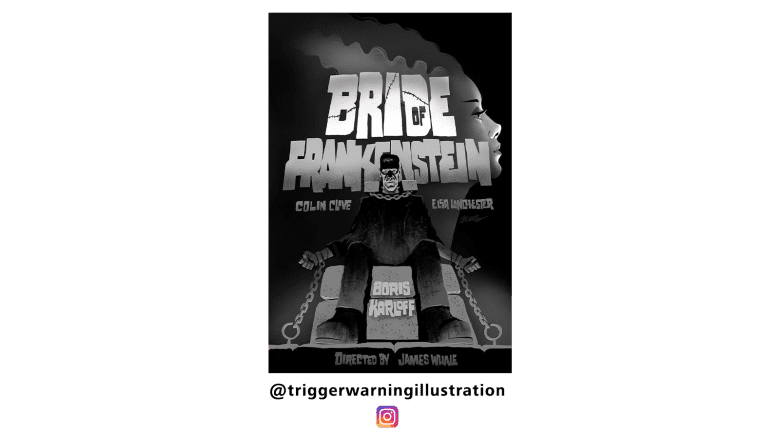@triggerwarningillustration (link: https://goo.su/HNvjN)
THE BRIDE OF FRANKENSTEIN (1935)
by Eric Lindbom –
Pressured to direct a sequel to his box office hit Frankenstein (1931), James Whale initially resisted. Since studio wunderkind Carl Laemmle Jr. was conveniently out of the country and out of Whale’s way during production, the director was granted artistic control, and his imagination and eccentric whimsy ran wild. Bride is generally pegged as his masterpiece and is perched at the tippy top of the Universal ‘30s/’40s horror cycle. It also plays beautifully with contemporary and even jaded viewers. Why does it endure?
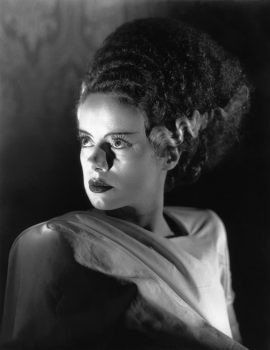
Gallows humor: In all four of his horror classics, Whale inserts laughs to prevent unintentional ones. Bride revels in modern mockery thanks to Ernest Thesiger’s fruity Dr. Pretorious, who blackmails Colin Clive into building the Monster a mate. Crinkly, ghoulish Thesiger is quotable throughout and famously offers a toast “to a new world of gods and monsters!” He beat out Bela Lugosi and Whale’s Invisible Man Claude Rains for the role.
Karloff: Like Garbo, posters back in the day trumpeted him on a last-name basis. Throughout, he achieves a heady mix of fury and poignance that none of the Monster actors that followed remotely touched. Karloff resented the decision here to have the Monster learn to speak scattered words. To him, the Monster’s inarticulateness was key to the character. In the non-Whale Bride sequel, Son of Frankenstein, in 1939, Karloff was mute again. The Monster never spoke again except for one solitary sentence from Glenn Strange in Abbott and Costello Meet Frankenstein (1948).
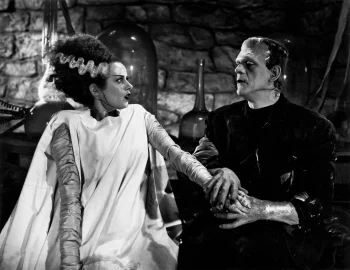
Tears: Despite Karloff’s gripe, audiences remain deeply moved by the Monster’s momentary bliss with the blind hermit (O. P. Heggie), who teaches him to speak, drink, and smoke a cigar. There are few dry eyes when an intruder, a cameo from future horror icon John Carradine, scuttles this rare period of Monster joy. Gene Hackman, an often-prickly actor on set, reportedly had a blast as the blind man in Mel Brooks’s Young Frankenstein (1974); he learned about the role while playing tennis with Gene Wilder.
The Production: Visually stunning shots abound. As noted in James Whale: A New World of Gods and Monsters by James Curtis, cinematographer John J. Mescall shot “in a “Rembrandt style – hard light with deep, rich shadows and brilliant highlights; it involves neither a straight cross light from the side nor a flat light directly in front but rather a combination of the two.”
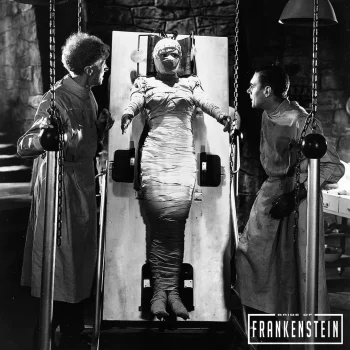
Franz Waxman: His musical score exhilarates, especially during the Bride’s creation scene, as the gurney lifts her into the open air. Some of his audio cues work on listeners subconsciously, like the kettle drum, which indicates the beating heart of the Bride when she comes to life.
The Bride: She disses the Monster with a hiss Elsa Lanchester overheard from Hyde Park swans. Her zig zaggy, lightning bolt hairdo turned fashion forward after Patricia Quinn copped it as Magenta in The Rocky Horror Picture Show (1979). After that, the look became a Halloween costume perennial for countless partiers too old to trick or treat. While 1985’s The Bride (with Jennifer Beals in the title role and Sting as Dr. Frankenstein) bombed, in September, actor/director Maggie Gyllenhaal gives it another go with The Bride!
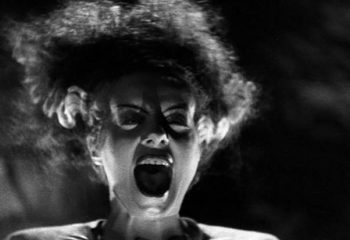
Eric Lindbom is a hardcore horror buff with a strong stomach, weaned on the Universal classics from the ’30s and ’40s. He’s written film and/or music reviews for City Pages, Twin Cities Reader, LA WEEKLY, Request magazine and Netflix. He co-edits triggerwarningshortfiction.com, a site specializing in horror, fantasy and crime short stories with illustrations by co-editor John Skewes. He lives in Los Angeles.


